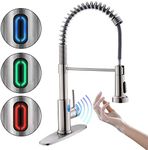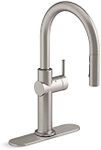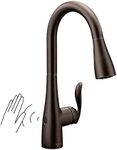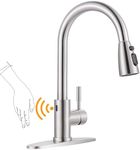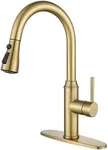Buying Guide for the Best Touchless Kitchen Faucets
Choosing the right touchless kitchen faucet can greatly enhance your kitchen experience by providing convenience, hygiene, and efficiency. When selecting a touchless kitchen faucet, it's important to consider several key specifications to ensure you pick the best fit for your needs. Understanding these specifications will help you make an informed decision and find a faucet that meets your requirements and preferences.Sensor TechnologySensor technology is what allows the faucet to detect motion and turn on or off without physical contact. This is important for maintaining hygiene and convenience, especially when your hands are dirty or full. Sensors can vary in sensitivity and range. Higher-end models may offer more precise and responsive sensors, while basic models may have a slight delay. Consider how often you cook and clean, and choose a sensor that matches your activity level in the kitchen.
Power SourceTouchless faucets require a power source to operate the sensors. They can be powered by batteries or an AC adapter. Battery-powered faucets offer flexibility in installation and are easier to set up, but you'll need to replace the batteries periodically. AC-powered faucets provide a continuous power supply, which can be more reliable, but they require a nearby power outlet and more complex installation. Think about your kitchen setup and whether you prefer the convenience of batteries or the reliability of a direct power connection.
Spout Height and ReachThe spout height and reach determine how much space you have to work with under the faucet. This is important for filling large pots, washing big dishes, and overall ease of use. Higher spouts and longer reaches provide more clearance and flexibility. If you have a deep sink or frequently handle large items, opt for a faucet with a higher spout and longer reach. For smaller sinks or less demanding tasks, a standard height and reach may suffice.
Flow RateFlow rate measures how much water the faucet delivers, typically in gallons per minute (GPM). This is important for water efficiency and performance. Higher flow rates provide faster water delivery, which can be useful for filling pots quickly, but they may use more water. Lower flow rates are more water-efficient and can help reduce your water bill. Consider your priorities between water conservation and performance, and choose a flow rate that aligns with your needs.
Material and FinishThe material and finish of the faucet affect its durability, appearance, and ease of cleaning. Common materials include stainless steel, brass, and chrome. Stainless steel is durable and resistant to corrosion, brass offers a classic look and durability, and chrome is easy to clean and maintain. Finishes can range from brushed to polished, and they impact the faucet's aesthetic and how well it hides fingerprints and water spots. Choose a material and finish that complement your kitchen decor and meet your maintenance preferences.
InstallationInstallation refers to how the faucet is mounted and connected to your plumbing. Some faucets are designed for easy DIY installation, while others may require professional help. Consider the number of holes in your sink or countertop, as some faucets require multiple holes for installation. If you're comfortable with basic plumbing tasks, you might prefer a faucet that's easy to install yourself. Otherwise, factor in the potential need for professional installation when making your choice.
Additional FeaturesAdditional features can enhance the functionality and convenience of your touchless faucet. These may include pull-down sprayers, adjustable spray patterns, temperature control, and pause buttons. Think about which features would be most useful for your cooking and cleaning habits. For example, a pull-down sprayer can make it easier to rinse dishes, while adjustable spray patterns can provide versatility for different tasks. Choose a faucet with features that will make your kitchen tasks more efficient and enjoyable.
